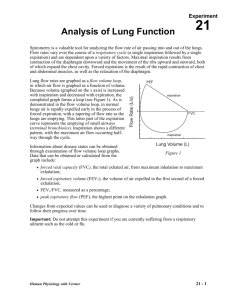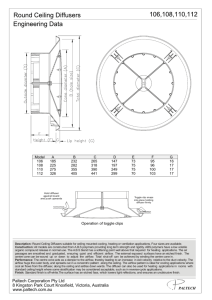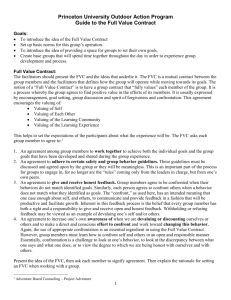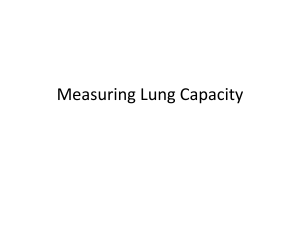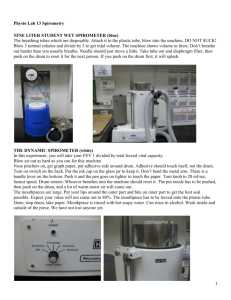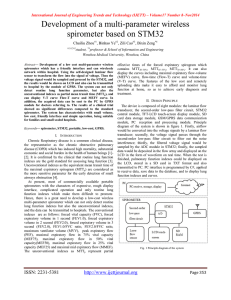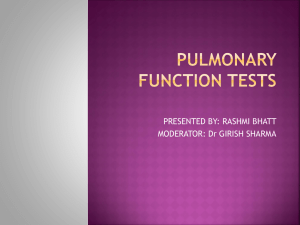Lab 5
advertisement
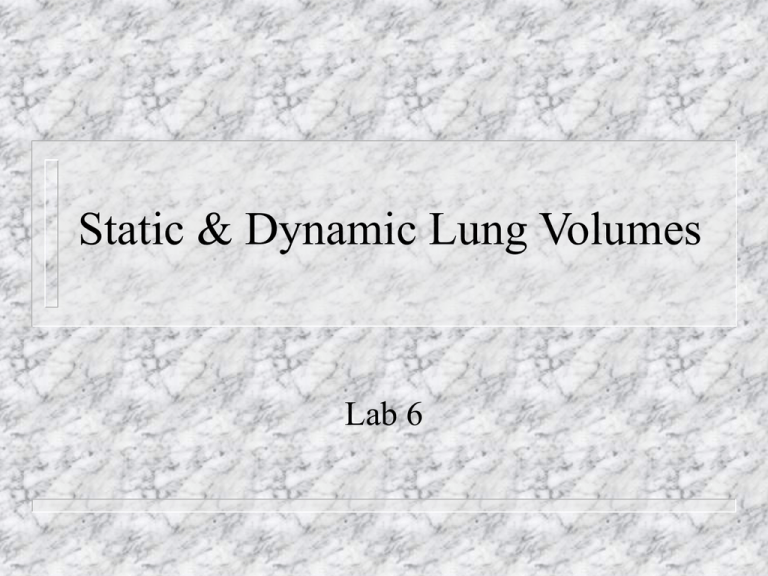
Static & Dynamic Lung Volumes Lab 6 Spirometer Classic instrument for measuring air volumes – Wet- Consists of an air collecting bell inverted in a vessel of water Amount of water displaced gives you estimate of the air required to displaces it Spirometer Useful for static volume measurement – – Vital capacity Peak airflow Limited usefulness when measuring rapid volume changes- speech – – – Inertia of the bell Sluggish response Total volume is not obscured but breath group data is! Chest Wall Measurement Lung volume can be determined from changes in rib cage and abdominal size Devices for transducing size changes: – – – – Magnetometers Mercury strain gauges Inductance plethysmography Respitrace Chest Wall Measurement Chest wall’s 2 parts (rib cage & abdomen), Contribute to the total lung volume change – Rib cage and abdomen movement are not 1:1 so calibration of abdomen & rib cage are completed Normal Adult- 20 year old Male Vtl Red= LV Green= RC Blue = AB Yellow= Audio Normal Adult- 20 year old Male Vtl LV RC AB Audio Multihandicapped MultihandicappedAdultAdult-3636year yearold oldMale Male Lt. Blue = Orange = Pt Red= LV Green= RC Blue = AB Yellow= Audio Multihandicapped Adult- 36 year old Male Pt Vtl LV RC AB Audio Articulatory & Phonatory Volumes Specific articulatory events & phonatory tasks can be measured by: – Spirometer- Although not accurate enough Poor – Respitrace- Also not accurate enough Poor – resolution & frequency response time resolution Pneumotachograph Integration of the flow signal to get volume Shows very small volume changes in a fraction of a second Pneumotachograph vs. Spirometer •Greater squareness of the corners indicate better frequency response Air Volume Measurements Volume is calculated by multiplying mean flow by the event’s duration – .123 (flow) x 20 (duration)= 2.46 L (volume) – Not always the most accurate method for measuring articulatory volumes Laboratory Purpose: – – – – Measure a patient's forced vital capacity (FVC) Evaluate maximum phonation volume Derive estimates of mean airflow from a volume record Estimate lung volume used for each breath group during reading of a standard passage (in absolute terms and as a %age of FVC) Laboratory Part I– – – FVC= maximum amount of air that can be expired after a maximal inspiration- represents the total amount of air that is available for use. Measure height of patient Measure FVC with spirometer or aerophone Max. inhalation at REL, then max exhalation 3 trials Determine patient’s expected FVC (norms or formula in Appendix G Laboratory Part II: – – Phonation volume (PV)= the maximum amount of air that is available for a maximally sustained phonation Use sample (figure A) of sustained /a/ for the lab questions Is PV normal (Use norms in text) Abnormal PV might occur in which pathological conditions? – For the patient exercise do a sustained /a/ on the aerophone, mark it and calculate volume. Laboratory Part III: – Assessment of lung volume change during a speaking task (how a patient manages air for speech purposes) Duration & relative volume of each breath group (amount of air expressed as a %age of VC) – Mark speaking record Use Figure B – Laboratory – Analysis questions for part III: Find REL- draw line across bottom of cycle Divide into 10 equal segments (10% each) Mark each breath group The FVC for this sample will be ? To calculate %age of VC: – – Volume (in Liters) x 100 / VC in L ex. .64 x 100/ 4.4= 14.5% Laboratory Mean airflow data – – Used to assess more general characteristics of ventilatory, laryngeal and/or articulatory function Mean speech airflow= volume of air the speaker uses divided by the duration of the utterance Laboratory Part IV: – Use Figs. 3 & 4 of the running speech samples and highlight the mean flow rate from your calculations baseline volume= where speech begins Finishing volume= where speech ends Total volume= baseline volume-finishing volume Speech volume of each breath group & expiration duration Mean airflow rate= mean speech volume/mean duration
